
Original Link: https://www.anandtech.com/show/1587
CES 2005: Chipsets, Motherboards, and Memory
by Wesley Fink on January 13, 2005 12:05 AM EST- Posted in
- Trade Shows
With the death of Comdex in 2004, the computer press had every expectation that CES would fill the void. That expectation turned out to be overly optimistic as many major players in the chipset, motherboard and memory markets did not even make an appearance at CES this year. Those who did sport a booth or suite at the Las Vegas extravaganza had little new to show - although we did finally see some products that had been expected for many months. At least this year, CES was nothing like Computex in Taipei, or even the defunct Comdex.
There were a few new items, but not the kind of "blow-your-mind" excess that we see at Computex. Since Las Vegas is the city that has turned sin into cash and gaudy excess into class, we really expected more in the computer arena. Yes, this is still the week that CES shares Las Vegas with the Adult Film industry convention, so you get a picture of this strange mixture of pornography and Consumer Electronics that makes this city a bizarre place to land just after New Year's each year. Somehow, the Porno Academy Awards seem a better fit to the texture of Vegas than Consumer Electronics, but both are fixtures in this neon oasis.
The taxi drivers are still some of the rudest that you will find anywhere with their constant complaining that computer people are cheap. Everyone in Vegas seems to believe that separating visitors from their dollars is their only reason to exist, and for too many in Vegas, good service is a foreign concept. We even overheard a Hotel store clerk complaining loudly that Bill Gates was cheap. He told the story that Gates came in the Hotel shop for a few items that came to $84 and "complained about the price - a man with the money he has!" What totally escaped the clerk was that that $84 probably bought goods truly worth about $5, based on the fact that I paid $5 for 5 bandaids in the same shop. Instead, the Vegas mindset seems to be "if you have the money, I deserve a big chunk of it."
While the overall depth in the computer arena was not impressive, it is not to say that there weren't some very interesting and exciting products at a few booths and suites. SLI was hot on the breath of every chipset and board maker, and there were even a few unique developments in the memory market.
nVidia nForce4
nForce4 launched on October 19th. Now, some 3 months later, you can only find 3 or 4 nF4 boards for sale at New Egg - two expensive SLI boards, a Gigabyte based on the lower-end 4X version of the chipset, and a value Chaintech Ultra. Based on what was on display at CES, that is about to change as the nF4 floodgates open.DFI
DFI was displaying two of the more interesting nForce4 boards at CES, and they tell us that you will be able to buy either of their new nForce4 boards by late January.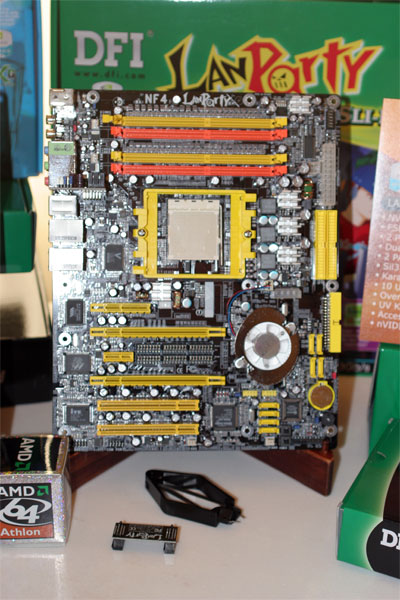
The full-blown DFI LANParty version is based on the nVidia nForce4 SLI chipset and has the kinds of features that enthusiasts have come to expect from DFI. This includes memory voltage to 4.0V from a default 2.5V, which should handle any memory overclocks and any memory that you might have in mind for this nF4. vCore is a similarly wide range to 2.1V from the default 1.5V. The single-chip nF4 is cooled by a new super low noise, long-life "magnetic levitation" fan. Audio is provided by the HD version of the Realtek audio codec on a Karajan module for the best possible Signal-to-Noise ratio. Yes, it is nVidia SLI with an x16 PCIe that can be split to two x8 with switches and a bridge. You will also be happy to see both an additional x4 and an x1 PCIe slot.
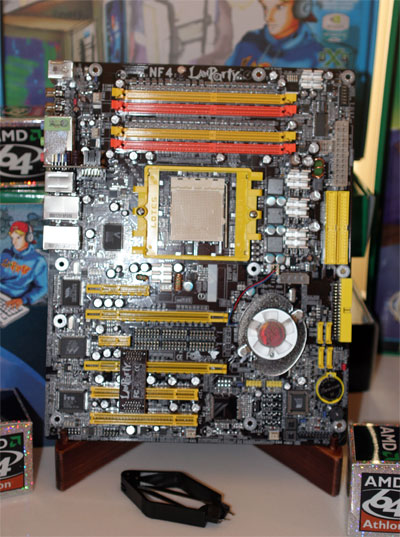
Both motherboards use jumpers instead of a switchable card to enable the use of two PCIe graphics cards. In order to save costs, DFI told us that they used the simple, but proven, method of jumpers instead.
For those still in the AGP camp, DFI also had the nForce3 250 socket 939 LanParty on display, but not in final PCB.
MSI
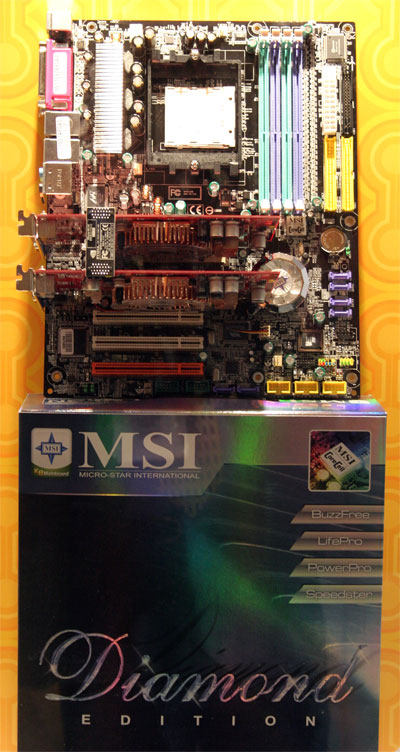
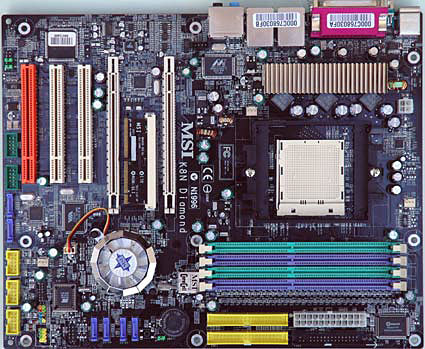
MSI confirmed with us that they are canceling their plans for an "SLI"-like motherboard based on the nForce4 Ultra chipset after pressure from nVidia to drop the project. The MSI "semi-SLI" Ultra has been mentioned a few times in the past, but apparently, the newest NVIDIA drivers prevent this SLI hack from working. EPoX and DFI are both introducing boards using a very similar principle to MSI's DBS solution, but they both also face the threat of NVIDIA pulling the plug with next generation drivers.
Abit
Abit has been closely tied to VIA chipsets in their recent Athlon 64 offerings. This time around, it was a bit of a surprise to see both an nForce4 Ultra Abit, called the AN8, along with the expected Abit board based on the VIA chipset.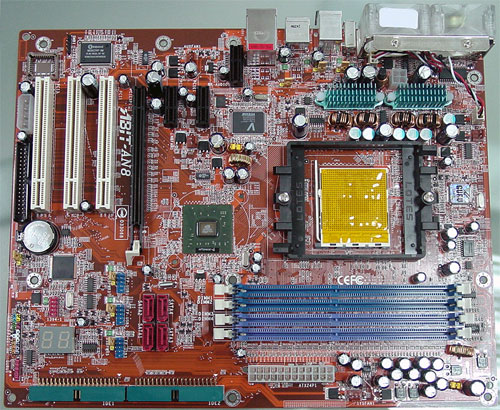
ASUS
Although there were only a few new products at ASUS, they were very excited to announce to us that they are working on a dual socket 940 solution to finally give MSI's Master series a run for its money.AMD's dual core socket 939 processors were also running in a back room on ASUS' A8N-SLI Deluxe motherboards - without modification. Although we had known for some time that dual core would only require a BIOS update on AMD motherboards (at worst), the knowledge that off-the-shelf motherboards running AMD's newest gave us a further boost of confidence for the future. This is also in stark contrast to Anand's report that Intel dual-core will not run on current 915/925 chipset motherboards.
VIA K8T890
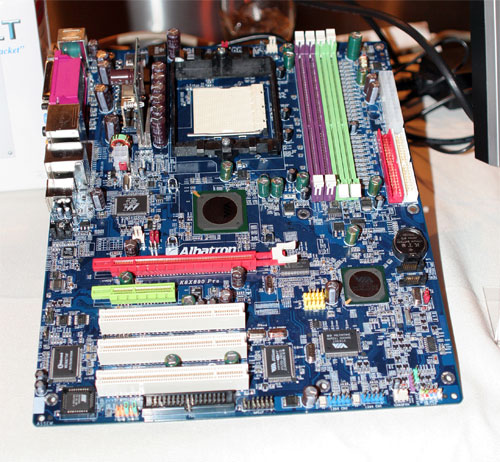
VIA "SLI"
VIA was also demonstrating a working machine with their version of dual video cards. The VIA solution is a bit different in that there is no bridge chip, slot 2 is x4, and any two video cards can be combined. VIA had combined an ATI X800 XT and an X300 in their dual graphics machine, but we did not have an opportunity to see benchmarks of the video performance.Abit
Abit has long had close ties to VIA, and Abit was also touting their new AX8 board.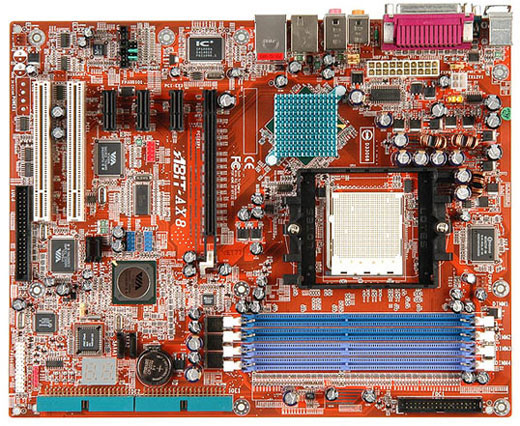
ASUS
ASUS will also launch their K8T890 solution in the form of the AV8-E Deluxe. Merchants are starting their pre-order sales now, and we are told that you can pick up the board from a few select merchants if you know where to look.ATI RS400/RS480
After the initial outpouring of love from the press, the RS480 chipset from ATI for AMD Socket 939 has gone almost silent. ATI tells us that enthusiast boards based on this chipset are still coming, and as proof they had a test rig set-up running 24/7 at DDR630 - a CPU frequency of 315.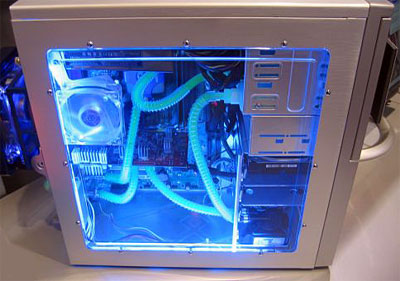
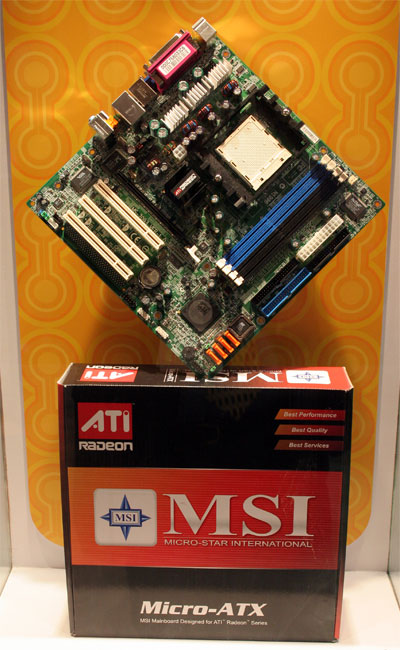
RS400 for Intel
We also saw the upcoming Intel version of the new ATI chipset at Asus and MSI.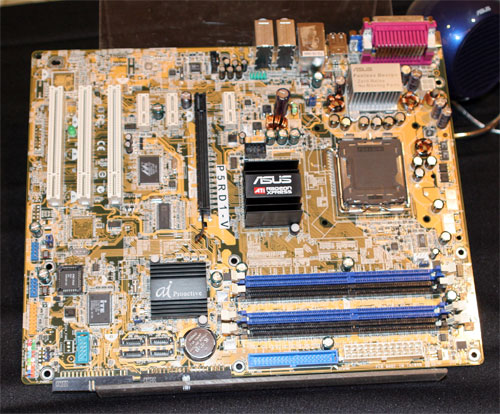
ATI has pooled a lot of help from ULI with the newest SB400 southbridge alternative, and a lot of help from unnamed partners to get their memory controller up to snuff. Hands down, ATI has the best IGP solution out there, but will the new RS400 chipset be enough for the enthusiast market as well?
Corsair Releases a Memory Light Show
Corsair has been moving toward providing instantaneous information about the performance of their memory. We saw the first efforts in this direction in the release of their PRO series with top-mounted LEDs in Corsair TwinX1024-4000 PRO: Improving DDR500 Performance. The latest from Corsair makes those initial efforts seem pale by comparison.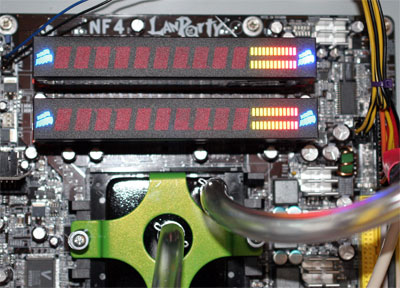
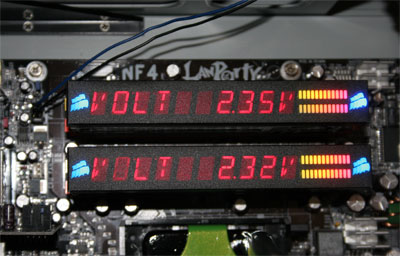
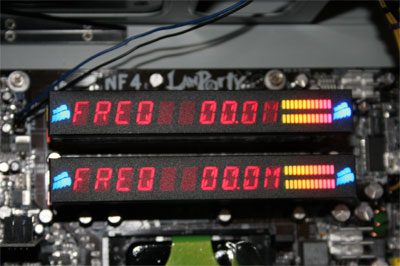
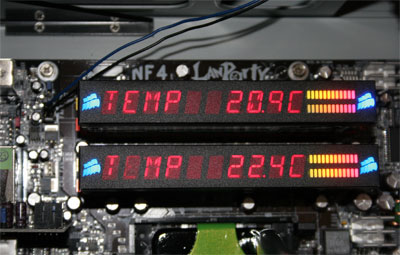
The messages scroll across the top of the Corsair DIMMs. While they do not actually improve performance, the color LED messages do look absolutely incredible in a side window case. The info that they provide could also save you some grief from overheated memory or rampant voltages, for example.
OCZ Introduces PLL Memory
OCZ was quietly showing a "small" addition to their memory construction, which they described as the addition of a PLL (Phase-Lock-Loop). The PLL IC monitors and corrects operating parameters of the memory, and theoretically, could improve the overclocking performance of the memory.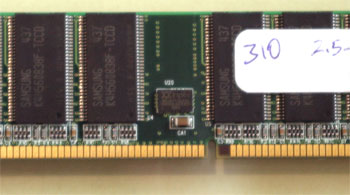
Final Thoughts
CES has come and gone, and along the way, some 140,000 people walked the CES Halls during the event. For the gadget geek, this show was an amazing resource, even if it wasn't quite as satisfying for Computer enthusiasts. Next year, CES promises to be even more massive, with additional halls that try to capture some of what was lost with Comdex. CES is already a strain on Vegas transportation, so a more massive CES is not a pleasant thought when you consider how to get from point A to Point B.Computex is still the show that most excites us computer types, but CES this year was filled with lots of promise for the future. If most of the companies exhibiting at CES could just figure out how to really spin "convergence" to truly include intelligence (computer technology), CES might emerge as a premier event in the Computer Press calendar. For now, CES provided a few bright flashes, but we are still looking to Computex-June-Taiwan for the sizzle.







